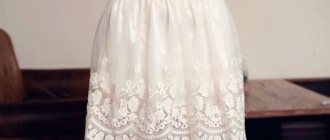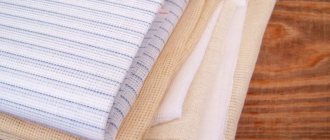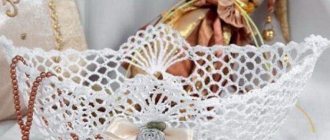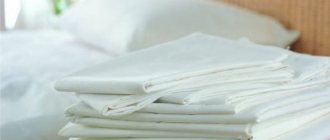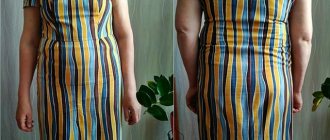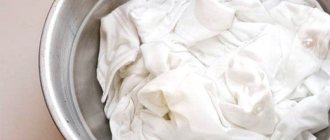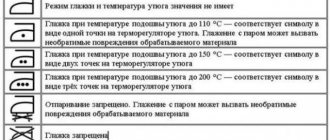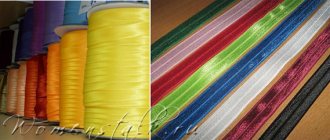Not all housewives know how to starch a dress correctly. And this procedure is very useful. Since ancient times, starching has been used to make clothes more luxurious. Various things can be used for this procedure: wedding and prom dresses, children's clothes. In addition, starch helps protect them from dirt; less dust accumulates on treated clothes and they don’t wrinkle as much. You can do this at home using a minimum of money and effort. Naturally, there are ready-made sprays that can be easily applied to small areas of fabric. But if you have to process the entire thing, then you will need a solution.
Why are garments starched?
A starched dress retains freshness and volume longer. For example, in ballet, all tutus are necessarily treated with the mixture before the performance so that they keep their shape and do not “fall” during various steps and ples.
At home, the use of starch is very wide. Previously, after washing, men's shirts, namely, collars and cuffs, were necessarily processed. Children's dresses also went through this procedure to give them pomp and wear. Even snow-white bed linen was dipped into the solution to maintain freshness.
Modern housewives and fashionistas starch things to solve the following problems:
- get a clearer and more voluminous shape;
- prolong the feeling of freshness and lightness;
- ensure that the fabric wrinkles less and does not require constant ironing;
- stiffen collars and cuffs.
A starched knitted skirt stretches less, and the pattern on it looks much more impressive.
Preparation of starch solution
After determining the degree of starch required and the amount of solution required, we begin preparation. From the amount of water used, you need to pour approximately 1-2 glasses into a separate container and dilute the starch in it until completely dissolved. Bring the rest of the water to a boil. Be sure to reduce the heat and add dissolved starch into the boiling water in a thin stream. Do not forget to constantly stir the prepared solution to avoid the formation of lumps. If this could not be prevented, you will have to strain the solution through several layers of gauze. The resulting paste should be transparent.
How to prepare laundry
To properly starch a dress, you must follow all the steps. Preparatory procedures include:
- normal washing;
- check for stains.
Tip: if you need to remove a stain from clothing, use hydrogen peroxide by mixing 2 tbsp. and 200 ml of water.
Types of processing
- Soft application is used for delicate and thin fabrics where high rigidity is not required, for example, for summer and knitted items.
- The middle version is prepared for bed linen and clothing made of cotton and linen.
- Hard finishing is used for cuffs, lace, frills and headpieces, as well as for the durability of petticoats and tutus.
Preparation of the solution
It all depends on a properly prepared mixture. If you do not follow the proportions, time, the solution will not turn out concentrated. As a result, the skirt will not be full. To prepare the solution you will need:
- the starch itself;
- boiling water;
- spoon or other mixing tool;
- glass container. Must be resistant to high temperatures. Sometimes the solution is boiled;
- the product itself.
Cooking method:
- starch is poured to the bottom of the container;
Cold water is added first. The mixture must be mixed thoroughly. The result will be a white consistency. It is viscous, reminiscent of sour cream;
the mass needs to be mixed. In this case, boiling water is added to the mixture. An important point: there should be no lumps in the mixture. If they form, you need to mix everything well with a spatula. Lumps will prevent clothes from starching. The consistency should resemble a paste;
If the solution turns out dark and cloudy, boil it for 5-10 minutes.
How to prepare starch? Video tip:
How to starch an elegant children's dress
Stages of work:
- wash;
- preparing the starch mixture;
- applying and drying the dress;
- ironing.
How to prepare the solution
A child’s dress requires special attention, because it should not prick after the procedure, so at home, choose one of the following options:
- For a soft version: dilute 0.5 - 1 tsp. starch in 1 liter of water and stir until smooth.
- For medium, 1 tbsp is enough. per 1 liter of liquid. Stir until lumps disappear.
- Strong concentrate: 2 tbsp. l. powder per 1 liter of water, and also add 1 tsp. boric salt (borax), which will give a special shine to the fabric.
The process of preparing “starch water” itself consists of several stages:
- Pour the required amount of starch into a suitable container and add 150-200 ml of cold water. Be sure to stir the mixture thoroughly until the lumps are completely dissolved.
- Boil the remaining portion of water. Add the prepared solution there, stirring constantly. When the liquid becomes homogeneous, the fire must be extinguished.
- Wait for the mixture to cool to room temperature and check the consistency. To do this, dip your hand in a clear solution, after which a slippery mark should remain on the skin.
- Pour all the contents into a washing basin and lower the item there for 1-2 minutes. You can rinse the fabric with your hands so that it is better saturated.
- Remove the clothing, wring it out, and shake it off. Then, leave to dry, first checking that there are no creases or folds in the fabric.
When everything is dry, you can iron and wear the updated outfit.
Ready-made products
Analogs can be found in household chemical stores. Such means reduce the time spent on preparing the mixture yourself. They are divided into two types:
- Spray or aerosol is used to starch collars, laces and other parts of clothing where increased rigidity is needed. Before use, you must read the instructions from the manufacturer. The average price per bottle is 100 rubles.
- Powder or liquid is suitable for tablecloths, petticoats or children's dresses. This product is used as an additional product for automatic washing. The average price per package is 250 rubles.
There is only one drawback to purchased starch compositions - you cannot control the level of hardness of the product obtained. When manually diluting classic starch, you can experiment, choosing the optimal ratio of water and powder for a specific outfit.
Step-by-step instruction
When deciding how to starch a dress at home, choose the simplest and most proven option:
- Prepare the desired consistency from powder and water. It must be warm.
- Place the baby's dress completely in the prepared liquid.
- Take it out and make sure that the starch “water” gets onto all areas of the suit. If there are untouched places, you need to repeat the procedure.
- Wring out and hang to dry on a hanger separate from the rest of the laundry.
After this, you can iron the outfit. As a result, you will get the same beauty as in many photos on the Internet.
How to properly process, dry and iron a petticoat
Often, it is necessary to starch the petticoat of a child's dress. And how to do this so that it retains its shape for a long time is the main question.
Tip: When working with multi-layered fabric, use a spray bottle to cover all layers.
You can dip the petticoat into the prepared warm mixture and rinse the fabric well in water with your hands, apply the solution with a sponge or spray. It should be dried on a hanger, separately from other things.
After drying, the petticoat should be ironed. To do this, be sure to turn off the steam function on the iron and use wet gauze as a layer between the household appliance and the fabric. You need to iron each layer in turn.
Video
Watch a video on how to starch a dress or other item using home remedies to understand the sequence of steps:
Tips and advice for housewives
The starching process gives products a clean and beautiful appearance. To make the procedure easier, as well as highlight the beauty of the dress, it is recommended to use six simple tips.
- Automatic starching. It is convenient to starch a dress in the washing machine using special liquid products (Frau Schmidt Ocean, Selena “Starch”, Bagi “Amilan”). The liquid, including a self-prepared starch solution, is poured into the conditioner tray and can be used together with the powder. The washing mode is selected in accordance with the structure of the fabric.
- Convenient ironing. To ensure that the fabric is ironed comfortably, does not stick to the iron and does not leave residue, it is recommended to add a few drops of turpentine or a little salt to the solution. In addition to convenient ironing, grains of salt will add shine to the fabric after drying.
- Rigid fixation. Collars, waistbands and cuffs require hard starching. For better fixation, it is recommended to add borax to the concentrated solution and let the finished product brew for two hours. There is no need to soak the entire product in the solution, just lower the edges of the sleeves, collars, and belt. For ease of application, you can also use a wide brush.
- Shine and neatness. A drop of blue will add radiant whiteness to white dresses. Milk will whiten and soften the fabric when smoothing (one tablespoon per liter of solution). A mixture of talc, borax and starch (3:1:5) gives a beautiful shine. It is not the product itself that is dipped into the solution, but the fabric for ironing. The dress is ironed through gauze soaked in the solution.
- Starching knitwear. For knitwear you will need one part PVA glue to two parts water base. No cooking or heating required. The product is lowered into the resulting mixture and soaked for several minutes.
- Color preservation. To prevent things from fading or losing color, it is not recommended to immerse them in a hot solution that has just been removed from the stove. You should wait until the liquid cools to room temperature.
Knowledge of how to properly starch a skirt and dress will be useful for women to create the ideal image of a bride, ballerina, or little princess. Starched items look lush, clean, and elegant. Housewives will choose for themselves the optimal method of starching fabric by trying professional and home remedies. Fabrics must be starched every time after or during washing.
Video on the topic
How to starch your wedding dress yourself
To treat a wedding dress at home, do the following:
- Before starching, carefully wash the outfit and check that there are no stains or dirt.
- Properly dilute the mixture of medium concentration (1 tablespoon per 1 liter of water). Dip the wedding dress into the warm liquid.
- If the skirt is full, it is better to spray all layers. Then, wring out and hang to dry on a hanger.
- Once dry, iron the dress.
Rules for preparing starch solution
To prevent damage to the product, it is very important to maintain the correct proportions when preparing the solution.
Before use, experiment - prepare a solution from one teaspoon. It should resemble jelly in thickness. Try starching an inconspicuous part of the skirt.
| Image | Instructions |
| Step 1 Place two tablespoons of starch on the bottom of the container. | |
| Step 2 Pour the powder into 50 ml of cold water and mix thoroughly. Then add another 50 ml of boiling water.
| |
| Step 3 Stir everything thoroughly so that there are no lumps.
|
TOP 7 products for starching
To starch things as quickly and easily as possible, pay attention to the following products:
- It is cheaper and easier to process products with regular starch.
- Aerosols from the Luxus Professional series with different scents. Even dry laundry can be treated with this product to give it shape. Average price 250 rub. for 500 ml.
- Citico - added when washing any items in the washing machine. Can also be used for hand washing. Cost about 400 rub. for 1 l.
- Sano Iron Starch – starch, 0.7 l volume. Used instead of steam when ironing, it gives things freshness and durability. But less effective than regular starch.
- Yplon Expert is an aerosol, sold in a can. Average price 130 rub. Suitable for petticoats and multi-layered products.
- Reinex is the most affordable ironing spray product. The cost is only 90 rubles. for one jar.
- For washing you can use Domal. It features economical solution consumption and good results.
There are many other ironing, washing and spraying products in the household chemicals department, so choosing the right option will not be difficult.
Drying
The solution must dry. To do this, place the dress or skirt on a hanger and straighten out all the details. This must be done, since the folds freeze. It will be difficult to straighten them out. Do not blow dry or place the item in a room where it is very hot. It is recommended to dry at room temperature. Cannot be placed on the balcony, especially in frosty weather.
While the dress is not yet dry, it is ironed. This way it will be easy to shape the outfit. If the outfit is already completely dry, it is moistened with water and then ironed.
Reviews
Marina
I have to constantly starch tutus because my daughter takes ballet classes. If I don’t have a special German remedy in a “Superform” spray on hand, then I use my grandmother’s methods. For the composition, I use only potato starch, although I heard that you can use rice and corn starch.
Tatiana
Once I starched a dark dress. It was my mistake, after which the item deteriorated, unpleasant stains appeared, which could no longer be removed. Now I use the recipe with gelatin. The composition is prepared quickly. The item holds its shape well after this, but it needs to be dried, as in the traditional method - on hangers.
Julia
I don’t starch dresses, but I am happy to carry out this procedure with knitted items. I make beautiful vases from napkins. The main thing is to give the product the desired shape in time. I just place the napkin on the bottle or vase and wait for it to dry. As a result, I get a beautiful vase.
Ancient starching methods
Previously, our grandmothers and great-grandmothers found a way out of the situation. For these purposes, they often used sugar, gelatin, and a little later, in some cases, PVA glue.
Sugar:
- The rigid shape of the clothes is given by the syrup, which is boiled in the ratio: 100 ml of water per 200 g of sugar.
Important! It is very important not to overcook the syrup. Otherwise, your item will acquire an unwanted yellowness.
- Pre-prepare a solution with starch and pour the cooled syrup into it.
- Mix the resulting mixture thoroughly.
Important! If there are any lumps left, you can strain the paste through cheesecloth.
- Lower the product and leave it to soak for a while.
- Squeeze out excess liquid.
- Place horizontally to dry.
Important! Under the influence of water, clothing will lose its acquired shape and rigidity. Therefore, make sure that after starching the product does not come into contact with water.
PVA glue
This method is perfect for knitted items or embroidery. To give things rigidity and the correct position of the threads, so that the pattern on the product looks more expressive, prepare the following remedy:
- Dilute PVA glue with water in a 1:2 ratio.
- Place the product in the prepared paste.
Important! If you need to treat individual parts, apply the product with a brush.
- Leave to dry straight.
Gelatin
Purchase gelatin at the grocery store and prepare the following solution:
- One tablespoon should be diluted in warm water until completely dissolved.
- Pour 200-250 ml of water into the resulting gelatinous liquid.
- Place the dress in the resulting mixture.
- Once it is saturated with gelatin, squeeze it out and lay it out to dry.

